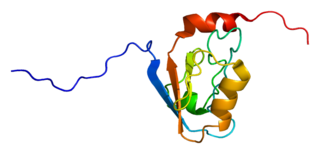Guanylate cyclase soluble subunit beta-1 is an enzyme that in humans is encoded by the GUCY1B3 gene. [5] [6]
Guanylate cyclase soluble subunit beta-1 is an enzyme that in humans is encoded by the GUCY1B3 gene. [5] [6]
Soluble guanylate cyclase (sGC), a heterodimeric protein consisting of an alpha and a beta subunit, catalyzes the conversion of GTP to the second messenger cGMP and functions as the main receptor for nitric oxide and nitrovasodilator drugs. [6]
GUCY1B3 has been shown to interact with Heat shock protein 90kDa alpha (cytosolic), member A1 [7] and Endothelial NOS. [7]

Cyclic guanosine monophosphate (cGMP) is a cyclic nucleotide derived from guanosine triphosphate (GTP). cGMP acts as a second messenger much like cyclic AMP. Its most likely mechanism of action is activation of intracellular protein kinases in response to the binding of membrane-impermeable peptide hormones to the external cell surface.

Guanylate cyclase is a lyase enzyme that converts guanosine triphosphate (GTP) to cyclic guanosine monophosphate (cGMP) and pyrophosphate. It is often part of the G protein signaling cascade that is activated by low intracellular calcium levels and inhibited by high intracellular calcium levels. In response to calcium levels, guanylate cyclase synthesizes cGMP from GTP. cGMP keeps cGMP-gated channels open, allowing for the entry of calcium into the cell.

Guanylate cyclase 2C, also known as guanylyl cyclase C (GC-C), intestinal guanylate cyclase, guanylate cyclase-C receptor, or the heat-stable enterotoxin receptor (hSTAR) is an enzyme that in humans is encoded by the GUCY2C gene.
An atrial natriuretic peptide receptor is a receptor for atrial natriuretic peptide.

Soluble guanylyl cyclase (sGC) is the only known receptor for nitric oxide, NO. It is soluble, i.e. completely intracellular. Most notably, this enzyme is involved in vasodilation. In humans, it is encoded by the genes GUCY1A2, GUCY1A3, GUCY1B2 and GUCY1B3.

Retinal guanylyl cyclase 1 also known as guanylate cyclase 2D, retinal is an enzyme that in humans is encoded by the GUCY2D gene.

Disks large homolog 3 (DLG3) also known as neuroendocrine-DLG or synapse-associated protein 102 (SAP-102) is a protein that in humans is encoded by the DLG3 gene. DLG3 is a member of the membrane-associated guanylate kinase (MAGUK) superfamily of proteins.

Disks large homolog 2 (DLG2) also known as channel-associated protein of synapse-110 (chapsyn-110) or postsynaptic density protein 93 (PSD-93) is a protein that in humans is encoded by the DLG2 gene.

Natriuretic peptide receptor A/guanylate cyclase A , also known as NPR1, is an atrial natriuretic peptide receptor. In humans it is encoded by the NPR1 gene.

Heat-stable enterotoxins (STs) are secretory peptides produced by some bacterial strains, such as enterotoxigenic Escherichia coli which are in general toxic to animals.

Cyclic nucleotide-gated channel alpha 1, also known as CNGA1, is a human gene encoding an ion channel protein. Heterologously expressed CNGA1 can form a functional channel that is permeable to calcium. In rod photoreceptors, however, CNGA1 forms a heterotetramer with CNGB1 in a 3:1 ratio. The addition of the CNGB1 channel imparts altered properties including more rapid channel kinetics and greater cAMP-activated current. When light hits rod photoreceptors, cGMP concentrations decrease causing rapid closure of CNGA1/B1 channels and, therefore, hyperpolarization of the membrane potential.

Guanylyl cyclase-activating protein 2 is an enzyme that in humans is encoded by the GUCA1B gene. Alternative names:

Guanylate cyclase soluble subunit alpha-3 is an enzyme that in humans is encoded by the GUCY1A3 gene.

Guanylate cyclase soluble subunit alpha-2 is an enzyme that in humans is encoded by the GUCY1A2 gene.

A nitrovasodilator is a pharmaceutical agent that causes vasodilation by donation of nitric oxide (NO), and is mostly used for the treatment and prevention of angina pectoris.

Adenylyl cyclase 10 also known as ADCY10 is an enzyme that, in humans, is encoded by the ADCY10 gene.

Riociguat is a drug by Bayer that is a stimulator of soluble guanylate cyclase (sGC). It is used to treat two forms of pulmonary hypertension (PH): chronic thromboembolic pulmonary hypertension (CTEPH) and pulmonary arterial hypertension (PAH). Riociguat constitutes the first drug of the class of sGC stimulators. The drug has a half-life of 12 hours and will decrease dyspnea associated with pulmonary arterial hypertension.
Guanylate cyclase-coupled receptors or Membrane-bound guanylyl cyclases are single-pass transmembrane proteins. Guanylate cyclase-coupled receptor on cell surface consists of two parts: the extracellular part, or the receptor domain, and the intracellular part, or the guanylate cyclase activity domain. When the receptor is activated by the ligation, it can cyclize the guanylate into cGMP. An example of Guanylate cyclase-coupled receptors is ANF receptors in kidney. Additionally, there exist intracellular guanylate cyclase-coupled receptor like soluble NO-activated guanylate cyclase.

Retinal guanylyl cyclase 2 also known as guanylate cyclase F (GUCY2F) is a protein that in humans is encoded by the GUCY2F gene.
Scott A. Waldman is an MD and biomedical scientist at Sidney Kimmel Medical College of Thomas Jefferson University, where he is the Samuel M.V. Hamilton Professor of Medicine, and also tenured Professor and chair of the Department of Pharmacology & Experimental Therapeutics. He is author of a pharmacology textbook, and former chief editor of Clinical Pharmacology & Therapeutics. He is known for his work in atrial natriuretic factor intracellular signaling through guanylate cyclase (GC), and the relation of Guanylyl cyclase C (GC-C) to the pathogenesis of colorectal cancer. Also for his hypotheses concerning the roles of intestinal paracrine hormones in satiety, obesity and cancer risk. Waldman also holds a concurrent position as adjunct professor at the University of Delaware, School of Health Sciences.